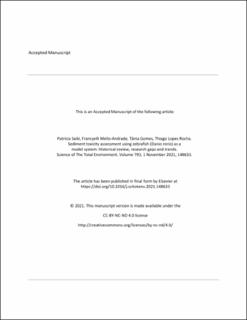| dc.contributor.author | Saiki, Patrícia | |
| dc.contributor.author | Mello-Andrade, Francyelli | |
| dc.contributor.author | Gomes, Tania | |
| dc.contributor.author | Rocha, Thiago Lopes | |
| dc.date.accessioned | 2021-10-13T07:41:59Z | |
| dc.date.available | 2021-10-13T07:41:59Z | |
| dc.date.created | 2021-10-12T14:02:12Z | |
| dc.date.issued | 2021 | |
| dc.identifier.citation | Science of the Total Environment. 2021, 793, 148633. | en_US |
| dc.identifier.issn | 0048-9697 | |
| dc.identifier.uri | https://hdl.handle.net/11250/2789508 | |
| dc.description | Embargo until June 22, 2023 | en_US |
| dc.description.abstract | Sediment is an important compartment in aquatic environments and acts as a sink for environmental pollutants. Sediment toxicity tests have been suggested as critical components in environmental risk assessment. Since the zebrafish (Danio rerio) has been indicated as an emerging model system in ecotoxicological tests, a scientometric and systematic review was performed to evaluate the use of zebrafish as an experimental model system in sediment toxicity assessment. A total of 97 papers were systematically analyzed and summarized. The historical and geographical distributions were evaluated and the data concerning the experimental design, type of sediment toxicity tests and approach (predictive or retrospective), pollutants and stressors, zebrafish developmental stages and biomarkers responses were summarized and discussed. The use of zebrafish to assess the sediment toxicity started in 1996, using mainly a retrospective approach. After this, research showed an increasing trend, especially after 2014–2015. Zebrafish exposed to pollutant-bound sediments showed bioaccumulation and several toxic effects, such as molecular, biochemical, morphological, physiological and behavioral changes. Zebrafish is a suitable model system to assess the toxicity of freshwater, estuarine and marine sediments, and sediment spiked in the laboratory. The pollutant-bound sediment toxicity in zebrafish seems to be overall dependent on physical and chemical properties of pollutants, experimental design, environmental factor, developmental stages and presence of organic natural matter. Overall, results showed that the zebrafish embryos and larvae are suitable model systems to assess the sediment-associated pollutant toxicity. | en_US |
| dc.language.iso | eng | en_US |
| dc.publisher | Elsevier | en_US |
| dc.rights | Attribution-NonCommercial-NoDerivatives 4.0 Internasjonal | * |
| dc.rights.uri | http://creativecommons.org/licenses/by-nc-nd/4.0/deed.no | * |
| dc.title | Sediment toxicity assessment using zebrafish (Danio rerio) as a model system: Historical review, research gaps and trends | en_US |
| dc.type | Peer reviewed | en_US |
| dc.type | Journal article | en_US |
| dc.description.version | acceptedVersion | en_US |
| dc.source.pagenumber | 14 | en_US |
| dc.source.volume | 793 | en_US |
| dc.source.journal | Science of the Total Environment | en_US |
| dc.identifier.doi | 10.1016/j.scitotenv.2021.148633 | |
| dc.identifier.cristin | 1945312 | |
| dc.source.articlenumber | 148633 | en_US |
| cristin.ispublished | true | |
| cristin.fulltext | postprint | |
| cristin.qualitycode | 2 | |

